
Rice University researchers have discovered a novel 3D crystalline metal that locks electrons in place due to a unique interplay of quantum correlations and the material’s geometric structure. This discovery highlights the role of flat electronic bands in determining a material’s properties and sets the stage for further explorations into quantum materials with pyrochlore lattice structures. Credit: SciTechDaily.com
New research validates method for guided discovery of 3D flat-band materials.
Scientists at Rice University have uncovered a first-of-its-kind material: a 3D crystalline metal in which quantum correlations and the geometry of the crystal structure combine to frustrate the movement of electrons and lock them in place.
The find is detailed in a study published in Nature Physics. The paper also describes the theoretical design principle and experimental methodology that guided the research team to the material. One part copper, two parts vanadium, and four parts sulfur, the alloy features a 3D pyrochlore lattice consisting of corner-sharing tetrahedra.
Quantum Entanglement and Electron Localization
“We look for materials where there are potentially new states of matter or new exotic features that haven’t been discovered,” said study co-corresponding author Ming Yi, a Rice experimental physicist.
Quantum materials are a likely place to look, especially if they host strong electron interactions that give rise to quantum entanglement. Entanglement leads to strange electronic behaviors, including frustrating the movement of electrons to the point where they become locked in place.
“This quantum interference effect is analogous to waves rippling across the surface of a pond and meeting head-on,” Yi said. “The collision creates a standing wave that does not move. In the case of geometrically frustrated lattice materials, it’s the electronic wave functions that destructively interfere.”
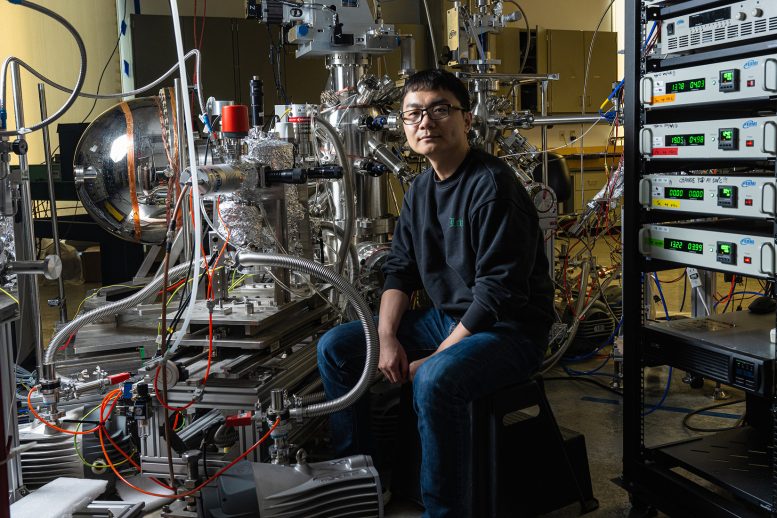
Rice University postdoctoral research associate Jianwei Huang with the laboratory apparatus he used to conduct angle-resolved photoemission spectroscopy experiments on a copper-vanadium alloy. The experiments showed the alloy is the first known material in which 3D crystal structure and strong quantum interactions frustrate the movement of electrons and lock them in place, resulting in a flat electronic band. Credit: Jeff Fitlow/Rice University
Electron localization in metals and semimetals produces flat electronic bands, or flat bands. In recent years, physicists have found that the geometric arrangement of atoms in some 2D crystals, like Kagome lattices, can also produce flat bands. The new study provides empirical evidence of the effect in a 3D material.
Advanced Techniques and Surprising Findings
Using an experimental technique called angle-resolved photoemission spectroscopy, or ARPES, Yi and study lead author Jianwei Huang, a postdoctoral researcher in her lab, detailed the band structure of the copper-vanadium-sulfur material and found it hosted a flat band that is unique in several ways.
“It turns out that both types of physics are important in this material,” Yi said. “The geometric frustration aspect was there, as theory had predicted. The pleasant surprise was that there were also correlation effects that produced the flat band at the Fermi level, where it can actively participate in determining the physical properties.”
In solid-state matter, electrons occupy quantum states that are divided into bands. These electronic bands can be imagined as rungs on a ladder, and electrostatic repulsion limits the number of electrons that can occupy each rung. Fermi level, an inherent property of materials and a crucial one for determining their band structure refers to the energy level of the highest occupied position on the ladder.
Theoretical Insights and Future Directions
Rice theoretical physicist and study co-corresponding author Qimiao Si, whose research group identified the copper-vanadium alloy and its pyrochlore crystal structure as being a possible host for combined frustration effects from geometry and strong electron interactions, likened the discovery to finding a new continent.
“It’s the very first work to really show not only this cooperation between geometric- and interaction-driven frustration but also the next stage, which is getting electrons to be in the same space at the top of the (energy) ladder, where there’s a maximal chance of their reorganizing into interesting and potentially functional new phases,” Si said.
He said the predictive methodology or design principle that his research group used in the study may also prove useful to theorists who study quantum materials with other crystal lattice structures.
“The pyrochlore is not the only game in town,” Si said. “This is a new design principle that allows theorists to predictively identify materials in which flat bands arise due to strong electron correlations.”
Yi said there is also plenty of room for further experimental exploration of pyrochlore crystals.
“This is just the tip of the iceberg,” she said. “This is 3D, which is new, and just given how many surprising findings there have been on Kagome lattices, I’m envisioning that there could be equally or maybe even more exciting discoveries to be made in the pyrochlore materials.”
Reference: “Non-Fermi liquid behaviour in a correlated flat-band pyrochlore lattice” by Jianwei Huang, Lei Chen, Yuefei Huang, Chandan Setty, Bin Gao, Yue Shi, Zhaoyu Liu, Yichen Zhang, Turgut Yilmaz, Elio Vescovo, Makoto Hashimoto, Donghui Lu, Boris I. Yakobson, Pengcheng Dai, Jiun-Haw Chu, Qimiao Si and Ming Yi, 26 January 2024, Nature Physics.
DOI: 10.1038/s41567-023-02362-3
The research team included 10 Rice researchers from four laboratories. Physicist Pengcheng Dai’s research group produced the many samples needed for experimental verification, and Boris Yakobson’s research group in the Department of Materials Science and NanoEngineering performed first-principle calculations that quantified the flat-band effects produced by geometric frustration. ARPES experiments were conducted at Rice and at the SLAC National Accelerator Laboratory’s Stanford Synchrotron Radiation Lightsource in California and Brookhaven National Laboratory’s National Synchrotron Light Source II in New York, and the team included collaborators from SLAC, Brookhaven and the University of Washington.
The research used resources supported by a Department of Energy (DOE) contract to SLAC (DE-AC02-76SF00515) and was supported by grants from the Gordon and Betty Moore Foundation’s Emergent Phenomena in Quantum Systems Initiative (GBMF9470), the Robert A. Welch Foundation (C-2175, C-1411, C-1839), the DOE’s Office of Basic Energy Sciences (DE-SC0018197), the Air Force Office of Scientific Research (FA9550-21-1-0343, FA9550-21-1-0356), the National Science Foundation (2100741), the Office of Naval Research (ONR) (N00014-22-1-2753) and the ONR-managed Vannevar Bush Faculty Fellows program of the Department of Defense Basic Research Office (ONR-VB N00014-23-1-2870).

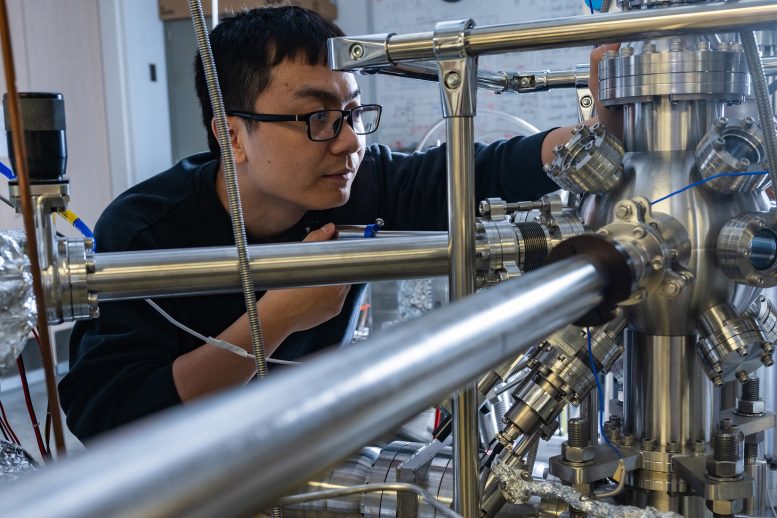


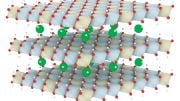
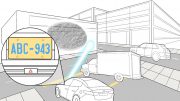

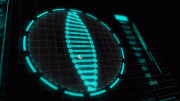


Please answer:
1. Can atoms be accommodated in 2D crystals?
2. Is an atom a 2D substance or a higher dimensional substance?
3. How can low dimensional spacetime matter provide space for high-dimensional spacetime matter?
4. Do researchers understand the physical reality of quantum states?
5. Is it scientific to use a cat to understand and study quantum mechanics?
6. Are mathematics and mathematical models scientific?
7.Are so-called academic journals (such as Physical Review Letters, Nature, Science, etc.) scientific and honest?
and so on.
Today, we have already entered the era of the internet. With the help of artificial intelligence and big data, discussions on scientific knowledge have become open and transparent. However, a group of editors of so-called academic journals (such as Physical Review Letters, Nature, Science, etc.) are mystifying themselves. They only care about their own so-called sufficiently high priority rating, general significance, discipline, novelty, etc., and do not care about what science and pseudoscience are.
Science and pseudoscience are not determined by a publication, an organization or a person, nor by you or me, but by mathematics the final say. Physical models must be based on mathematics or mathematical models in order to be scientific, convincing, and in accordance with natural laws.
The branch of mathematics known as topology has become a cornerstone of modern physics. The perpetually swirling topological vortices defy traditional physics’ expectations. A physical properties of topological vortices is their to spontaneously begin to change periodically in time, even though the system does not experience corresponding periodic interference. Therefore, in the interaction of topological vortices, time is both absolute and relative,and physics often requires treating space and time at the same level.
Low-dimensional spacetime matter is the foundation of high-dimensional spacetime matter. Low-dimensional spacetime matter (such as topological vortex) can form new material structures and derive more complex physical properties via interactions and self-organization. It is extremely wrong and irresponsible to imagine low dimensional spacetime matter using high-dimensional spacetime matter.
Science must follow mathematical rules. For example, the Standard Model (SM) is considered to be one of the most significant achievements of physics in the 20th century. However, the magnetic moment of μ particle is larger than expected, revealed by a g-2 experiment at Fermilab, suggests that the established theory (such as SM) of fundamental particles is incomplete. Furthermore, the SM omitting gravitation, it not involved the time problem and when the particle movement starts. Mathematics is the foundation of science. Physics must respect the scientific nature of mathematics and mathematical models. The SM must be based on mathematical models in order to be scientific, convincing, and in line with natural laws.
I hope researchers are not fooled by the pseudoscientific theories of the Physical Review Letters (PRL), and hope more people dare to stand up and fight against rampant pseudoscience.
The so-called academic journals (such as Physical Review Letters, Nature, Science, etc.) firmly believe that two high-dimensional spacetime objects (such as two sets of cobalt-60) rotating in opposite directions can be transformed into two objects that mirror each other, is a typical case of pseudoscience rampant.
If researchers are really interested in Science and Physics, you can browse https://zhuanlan.zhihu.com/p/643404671 and https://zhuanlan.zhihu.com/p/595280873.